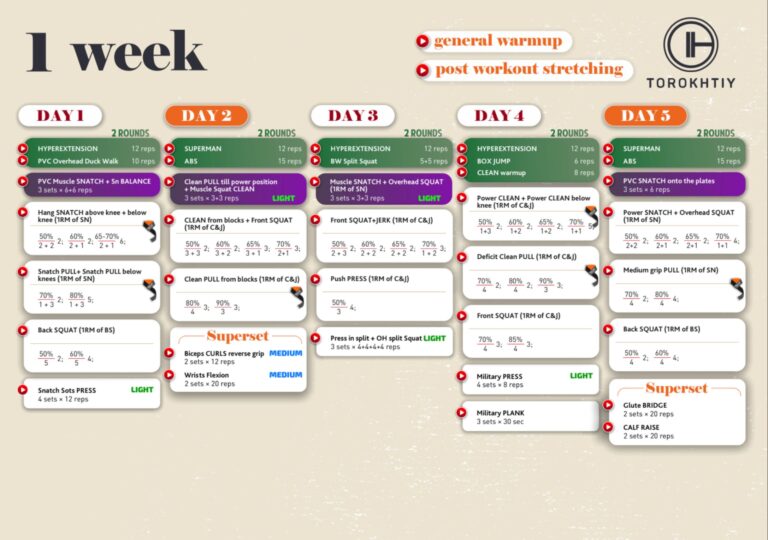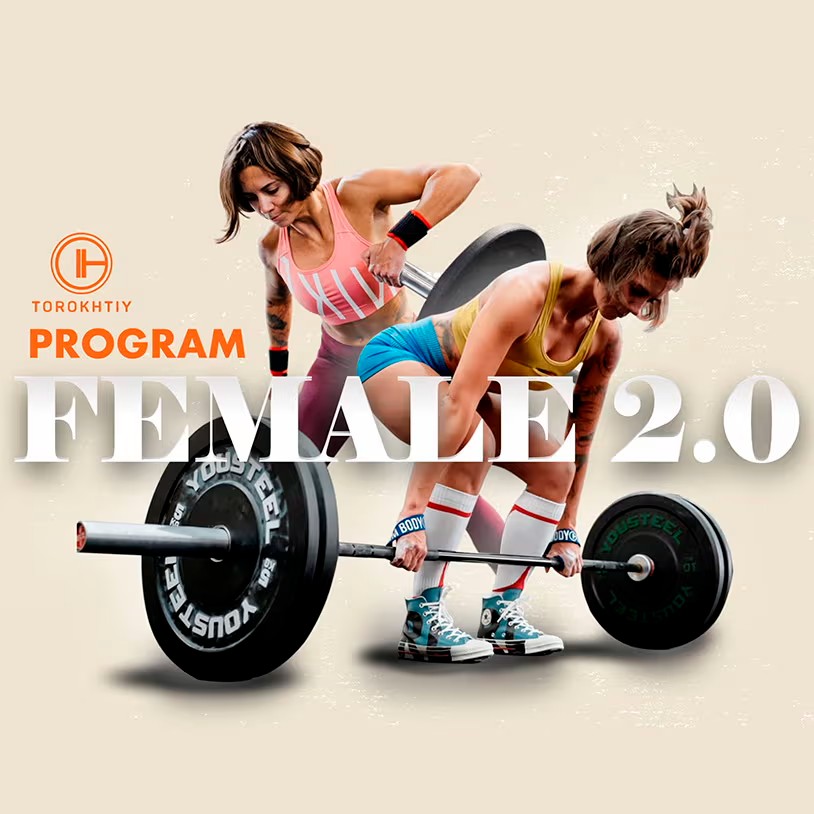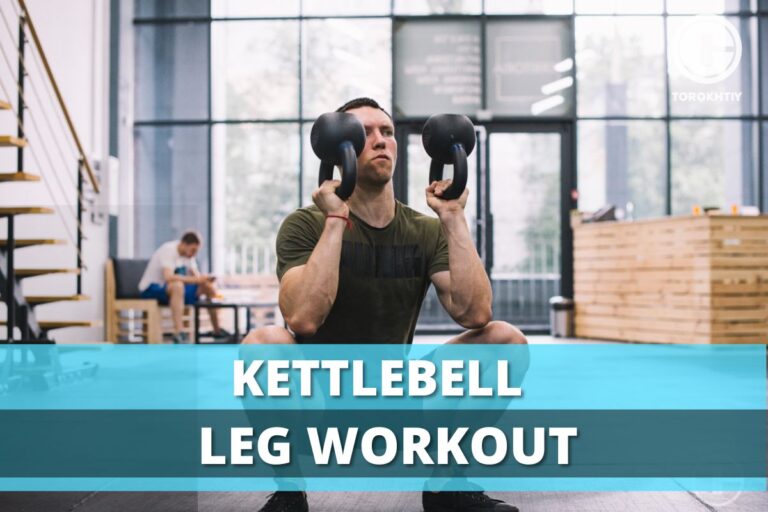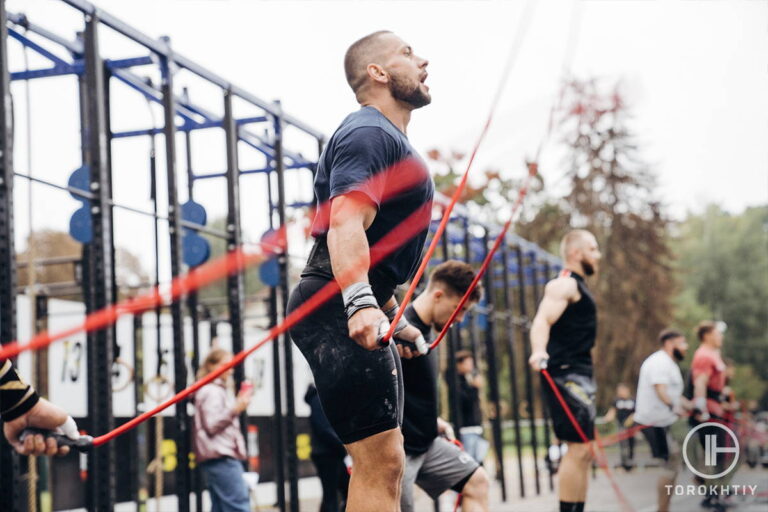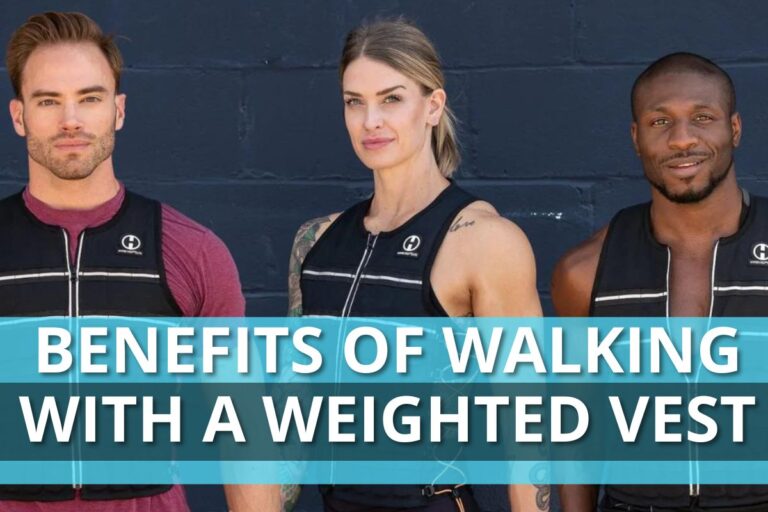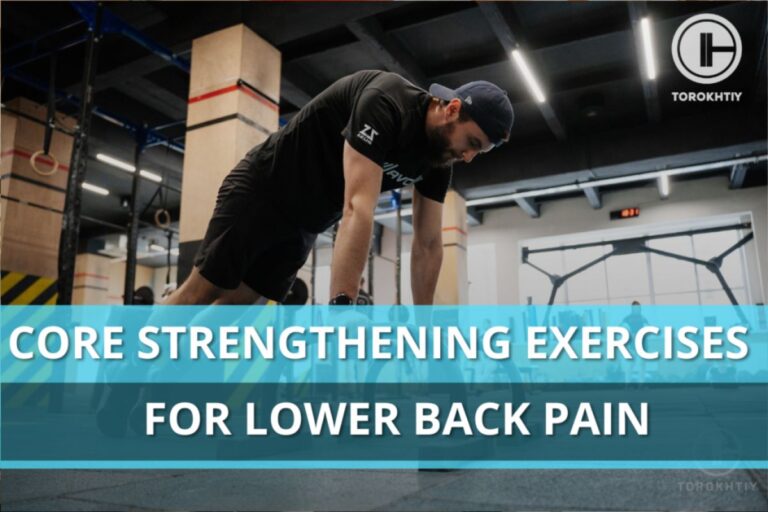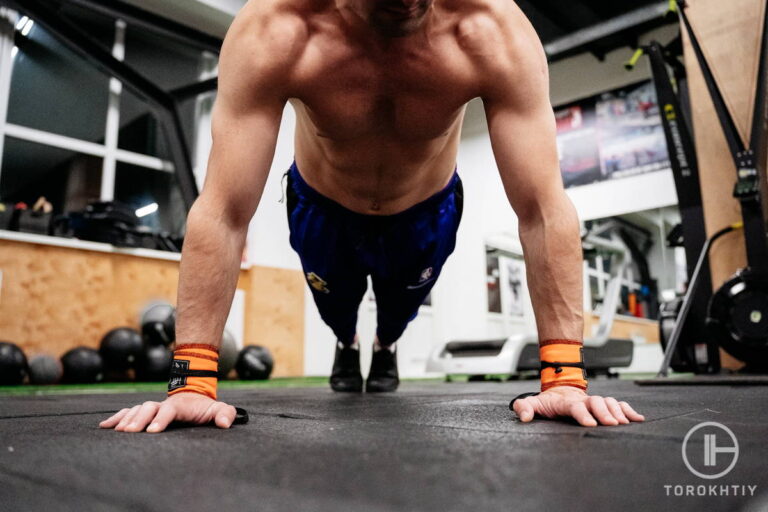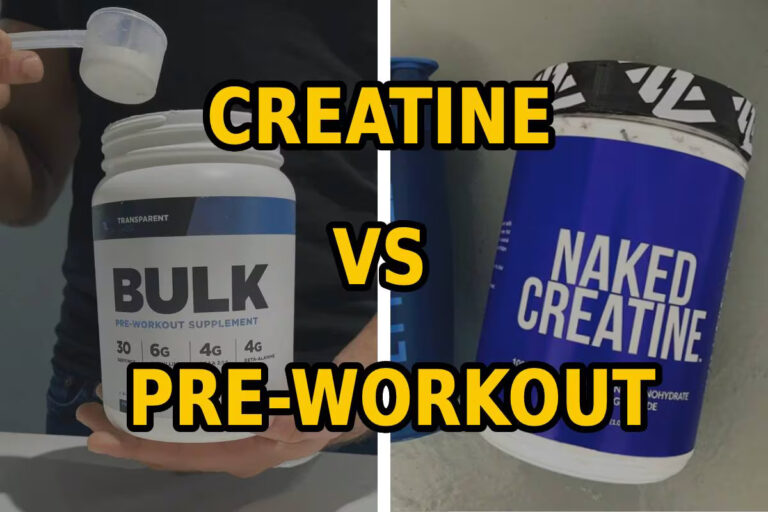12-Week Weightlifting Program For Women (Detailed Example)
Reviewed by: Oleksiy Torokhtiy (21 years of Oly Lifting experience)
When it comes to competitive sports, people are always looking for ways to excel and up their performance – this is where the Female 2.0 Program comes in. It’s a comprehensive 12-week program (with a two-week bonus!) that’s meticulously crafted to suit the needs of female athletes and shows how far female Olympic weightlifting training has come.
It starts with the General Preparation phase to prime and strengthen your body for the challenges that come, and then seamlessly transitions to the Special Preparations phase, where it focuses on laying the groundwork for peak performance.
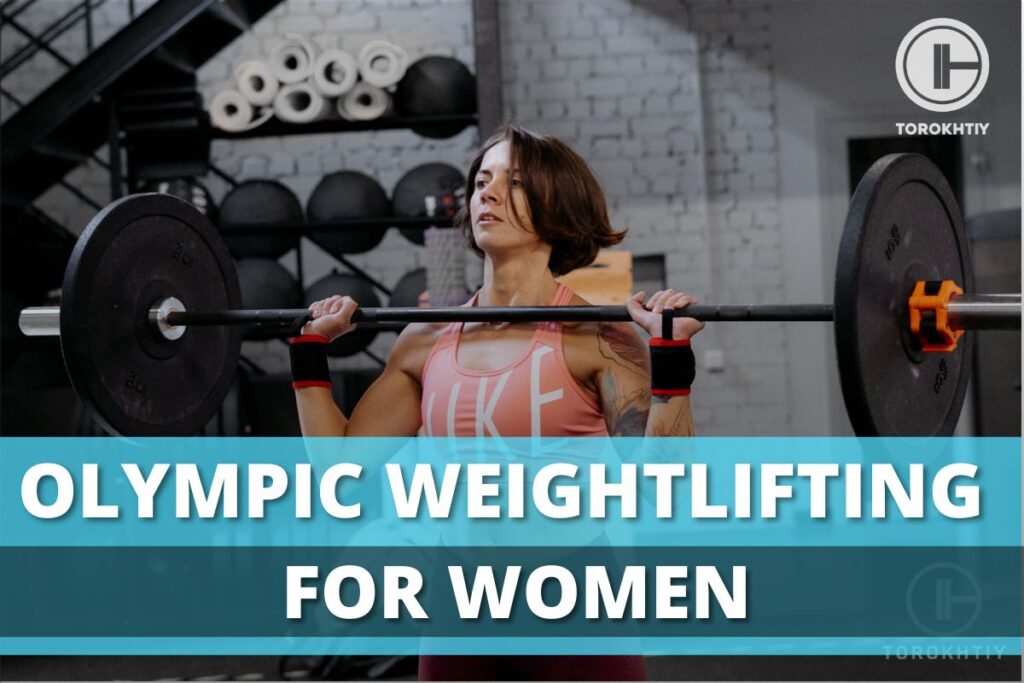
By the time you reach your PR, you’re ready for competition.
But besides the training periods, this program also has over 50 workouts and a library containing video exercises with step-by-step instructions.
It may be easy to dismiss this program as a mere strength training program for women, but it’s so much more – it’s about weightlifting as a sport, it’s about athleticism, about enhancing lifts, and improving health.
What you’ll gain here is a path to help women perform better at a competitive level, such as the Olympics, among other legends of the sport.
8 Benefits of Weightlifting for Women
When it comes to taking your workouts to the next level and really pushing yourself, there are very few tools that compare to the trusty old barbell.
Olympic weightlifting was long considered to be male-dominated, but luckily, we’re breaking through that stereotype, and each day, we see more and more women discovering the benefits weightlifting has.
Do you remember how the focal point of women’s workouts used to be light dumbbells and treadmills? Well, those days are gone and we’re happy to be rid of them.
Olympic Weightlifting routine for women is much more than just lifting weights and getting fit. It’s about transforming your body, having a sense of accomplishment, boosting your confidence, and improving your well-being overall. The benefits of Olympic weightlifting are tangible and go way beyond the bar and the weights.
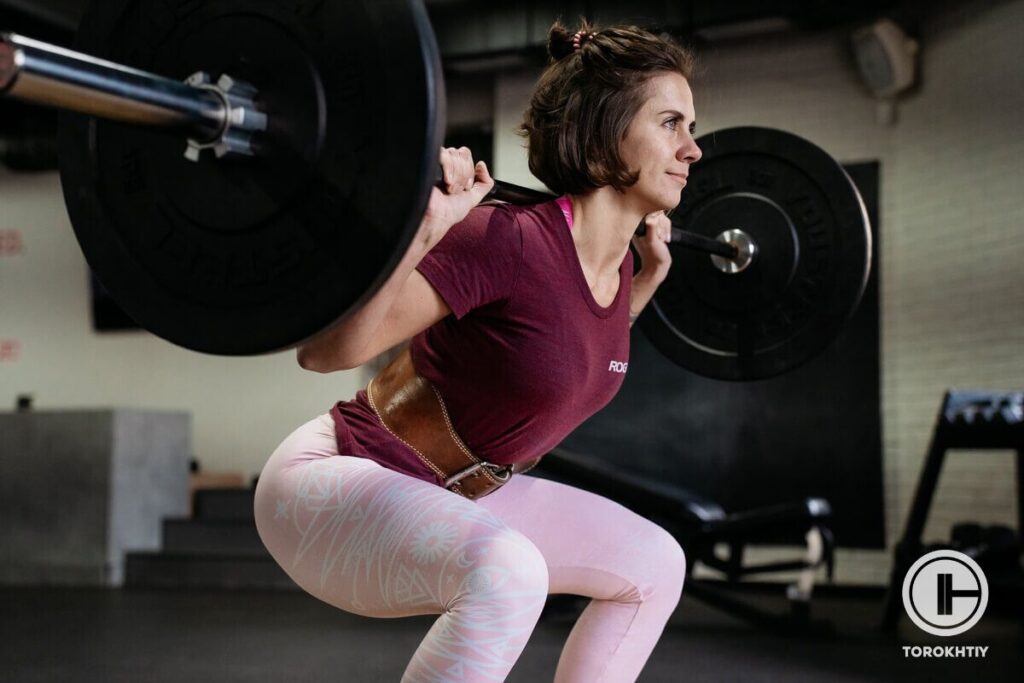
✅ Improving Strength and Gaining Muscle
This is one of the main benefits and, let’s face it, one of the main reasons most people in general start lifting weights. They want to get big, buff, and strong, and what better way to do that than with weightlifting.
There’s a very common misconception that women who lift weights bulk up all of a sudden, like bodybuilders do. This, however, is absolutely not the case. If you follow a weight training program for women, you’ll develop lean, toned muscles.
✅ Improved Metabolism
It won’t come as a surprise that weightlifting will give your metabolism quite a boost, which will then help burn more calories. This is great for weight loss and management and makes weightlifting a very important part of any fitness journey.
Muscle tissue needs to consume more energy than fat tissue, so if you have more muscle, it means that your body needs to burn more calories. The best part about this is that this calorie burn happens even when you’re not working out.
✅ Bone Health
Weight-bearing exercises and resistance training (which includes weightlifting) are excellent for bone density and preventing osteoporosis. Osteoporosis is more common in women, so this benefit is especially important for them.
The stress that is placed on the bones when you lift weights encourages your bones to become denser and less prone to fractures.
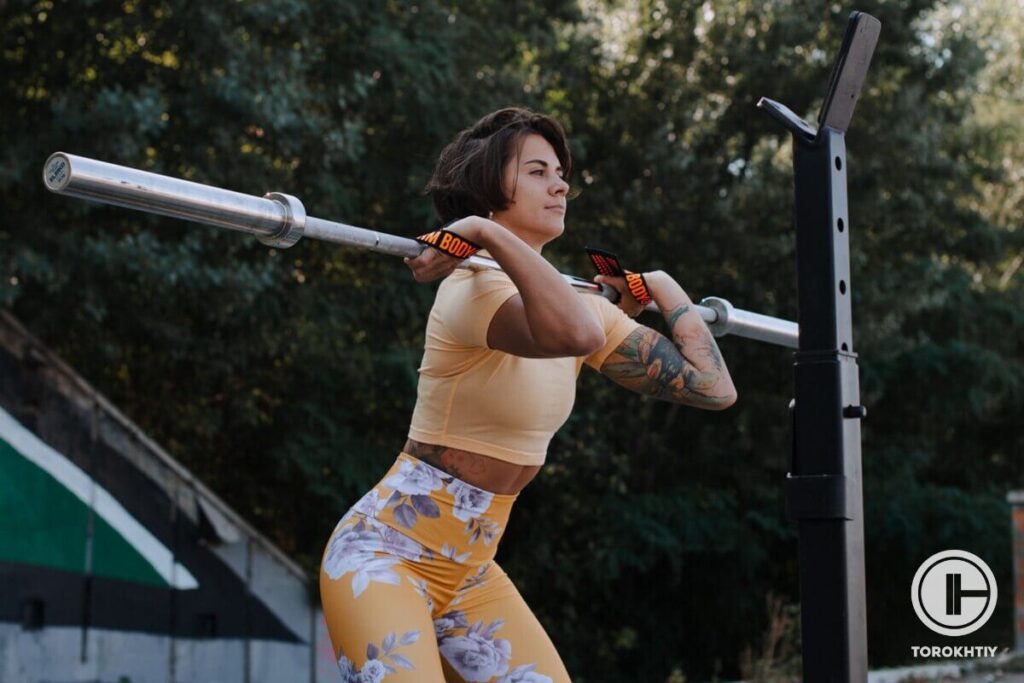
✅ Full-Body Workout
Olympic lifting training is very versatile, and it allows for a lot of compound movements like snatches, cleans, jerks, squats. These movements will engage multiple muscle groups at once, which makes the workout very efficient.
But the best thing about this is that these workouts don’t just target your large muscle groups. They also target your stabilizer muscles, which means that you don’t have to worry about muscle imbalances, because targeting stabilizer muscles promotes balanced strength development.
✅ Functional Strength
Barbell workouts mimic real-life movements, which means they promote functional strength that helps you in your day-to-day activities. Think about lifting groceries, moving furniture, or even picking up children – the strength you develop during your workouts translates to all of this.
✅ Body Composition
Body composition is where barbells really shine and can help women achieve a balance of lean muscle and less body fat. Resistance training is a part of every weight training routine for woman and will increase the mass of your muscles, which will then help burn more calories. This leads to a more defined, healthy appearance.
✅ More Confidence
Achieving any kind of goal will boost your confidence, and your fitness goals are no exception. Seeing your body become leaner and stronger can do wonders for your confidence. Setting and reaching goals at the gym can also have a ripple effect and improve your confidence in other aspects of life as well.
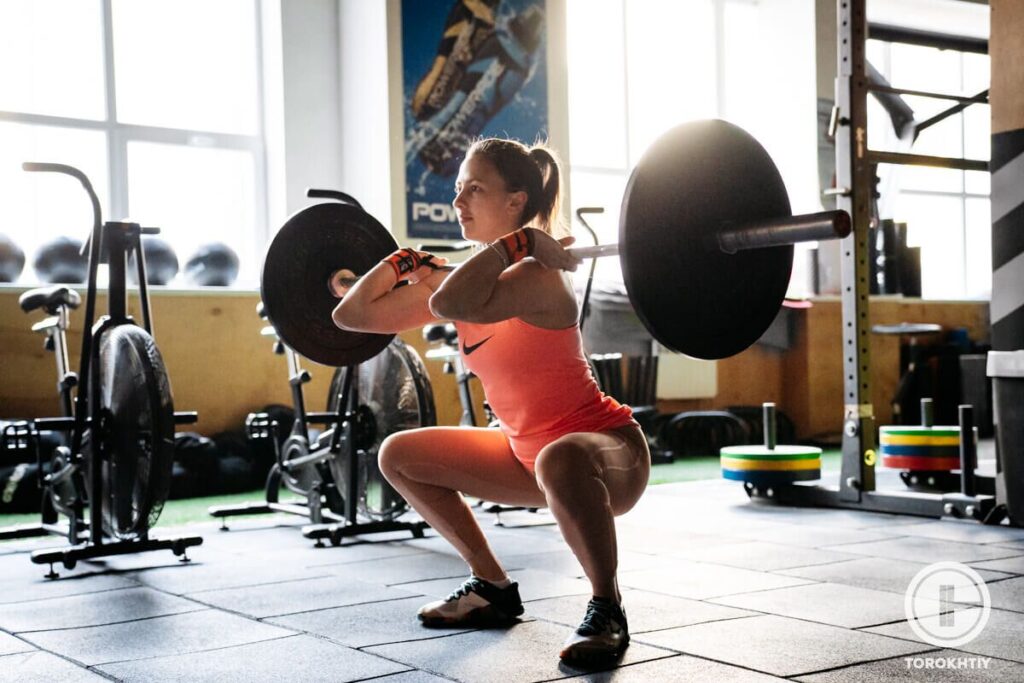
✅ Less Stress
The modern world brought about so many wonderful benefits, but it also brought something else – stress. These days, stress is unfortunately a normal part of anyone’s life and unless you find a way to reduce it and deal with it, you will have some serious health consequences.
Weightlifting (and exercise in general) is a great way to reduce the stress of your everyday life. It releases endorphins, which are known to reduce stress and improve your mood. This is a natural way to fight anxiety and depression and the focus during a weightlifting session can be a meditative experience.
🔻Weightlifting Program for Women (12 Week)
Transform your strength with our 12-week Olympic Weightlifting Program for Women, designed by Olympian, World, and European Champion Oleksiy Torokhtiy.
Three focused periods, from general preparation to peak performance, ensure you’re equipped for success.
Program details:
- 12 weeks + 2 bonus weeks;
- 5 days / week;
- 45-120 minutes per session;
- 50+ specific exercises;
- Primary focus on Olympics Lifts;
- Full access to all training content.
Start now and boost your weightlifting results!
5 Women Weightlifting Myths
When it comes to fitness in general, there are a lot of myths surrounding it. Olympic weightlifting, in particular, has been the target of so many myths that you can’t even count them.
This is a real issue because believing these myths can prevent you from giving the workout a try and with it, you’re limiting your life from all of the benefits it has to offer.
Barbells and free weights have incredible benefits for women and debunking the myths around them is important. A weightlifting exercise for women who utilize these tools can be the start of an actual transformation, and this doesn’t refer to your appearance only.
We’ve already gone over the one about women getting bulky from weightlifting but unfortunately, there are a lot more of them. Let’s go over the most common myths and debunk them – once and for all.
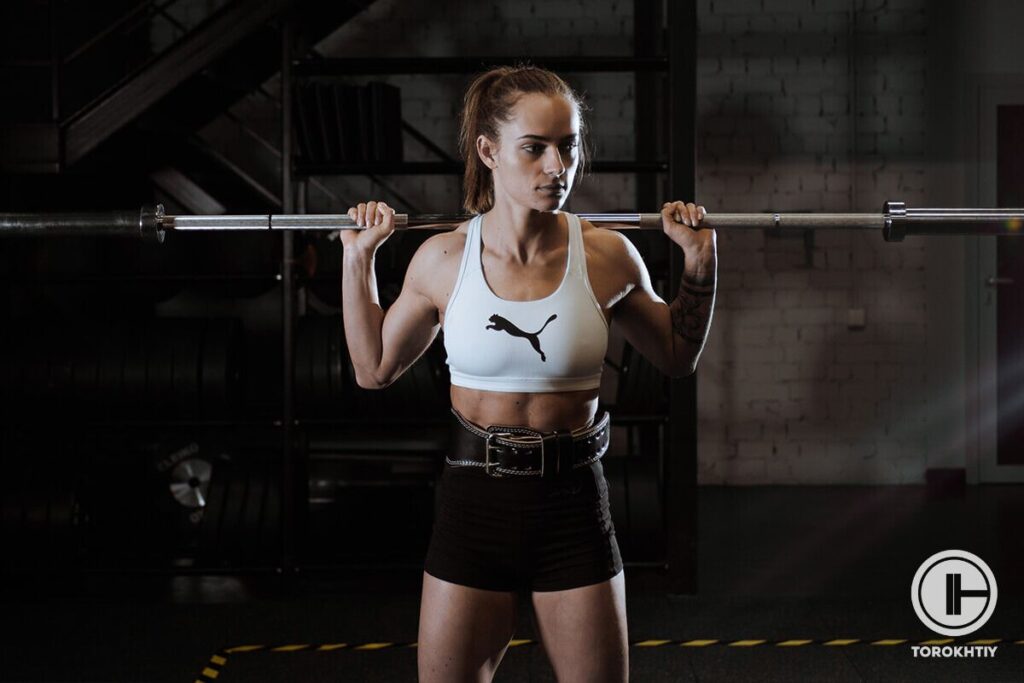
1. Cardio Is Better for Losing Weight
It’s true that cardio burns a lot of calories during the workout, but weightlifting increases your resting metabolic rate. This means that you’re burning calories even while you’re lying on your couch and watching Netflix. So, while cardio is great, weightlifting is a better long-term solution.
2. Women Should Only Lift Light Weights
This myth is borderline disturbing because women can have an enormous amount of benefits from lifting heavy weights. This is especially noticeable with barbells.
They allow you to progressively add weight and build your strength and muscles over time. When it comes to light weights, they’re a good start, but should not be the main focus.
There’s absolutely no reason for women to avoid heavy weights. In fact, focusing on light weights only will inevitably lead to slowing the progress down and in the end, it will come to a plateau. You’ll end up feeling stuck and unmotivated and possibly quit weightlifting altogether. So, by all means, give those heavy weights a try.
3. Weightlifting Is Bad for Joints
Another big, fat nope. People who think this don’t know anything about form and the importance of maintaining it. But if you take any exercise and do it without proper form, you’ll most likely end up hurting yourself in some way.
If you’re familiar with the correct form and keep it during weightlifting, not only is it not bad for the joints, but it’s the exact opposite. Weightlifting can help strengthen the joints and reduce the risk of injuries.
Not to mention, it can also help prevent and manage conditions like osteoporosis and arthritis because it promotes bone density and joint health.
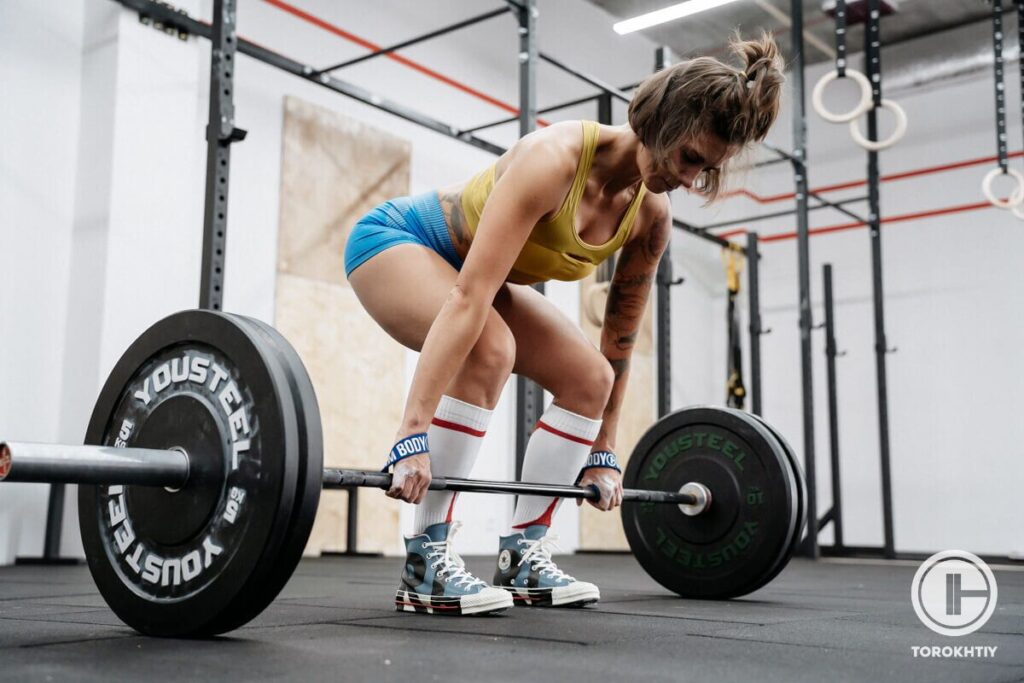
4. Weightlifting is Complicated and Intimidating
If you’ve never tried it and you’re looking at a professional’s workout, of course, it’s going to be intimidating. Everything seems hard and intimidating at first, but you shouldn’t let that stop you. Remember that no growth ever comes from staying in your comfort zone.
You need to start with lighter weights to familiarize yourself with the movements and the form. A great way to start is with a trainer so you can safely master the basics. When you’re done with that, you can (gradually!) go on to more complex exercises and heavier weights.
5. Weightlifting is Only for Young Women
Well, that just couldn’t be farther from the truth. Weightlifting is suitable for women of all ages, including older adults.
The truth is, the more you age, the more important weightlifting becomes. As you get older, your bones become less dense and frail. Weightlifting is a great way to increase bone density, maintain muscle mass and counter issues related to old age.
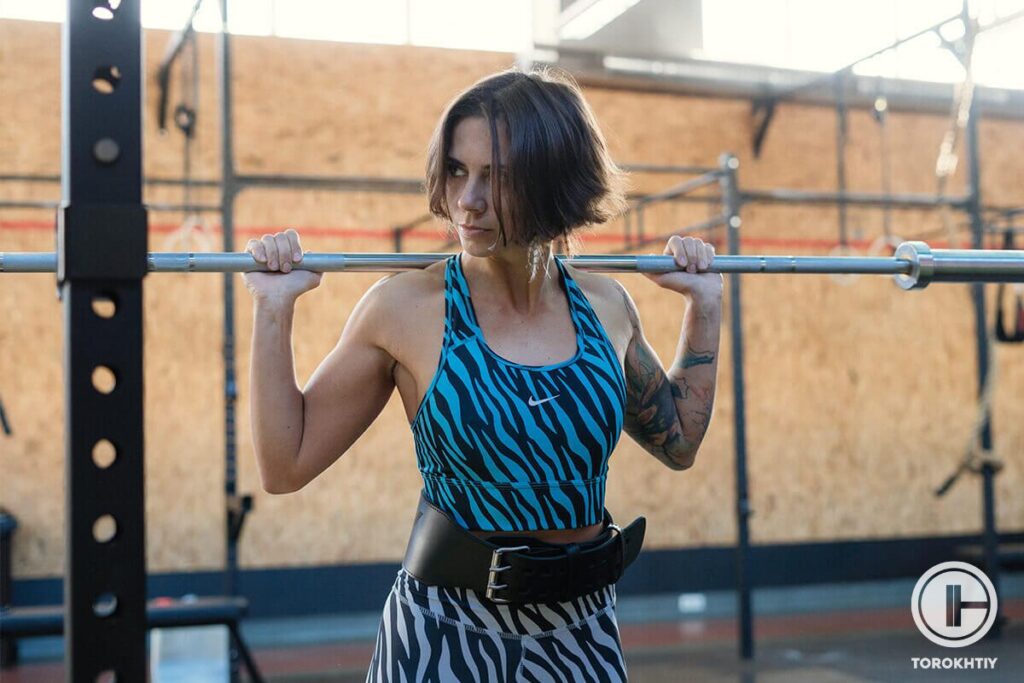
Program for Beginners vs Intermediate vs Advanced Female Lifters
Starting an Olympic weightlifting journey can be very exciting. You’re motivated and ready to transform your body, health, and life overall. Changing your lifestyle, even if the changes aren’t drastic, is usually quite refreshing.
But when it comes to Olympic weightlifting, there’s something that often gets overlooked – the level of fitness. People mostly overestimate their fitness level and start with an intensity way above what’s comfortable and healthy.
This can lead to soreness, strain, and injuries. Before you know it, you’re giving up on your workout routine before it’s even established.
Recognizing your fitness level is important altogether, but especially regarding Olympic weightlifting. It’s important to start according to where you’re at, as anxious as you are to progress further.
We’ll now explore what each fitness level is like, what’s important for it, and what weightlifting workouts for women you can do according to your level.
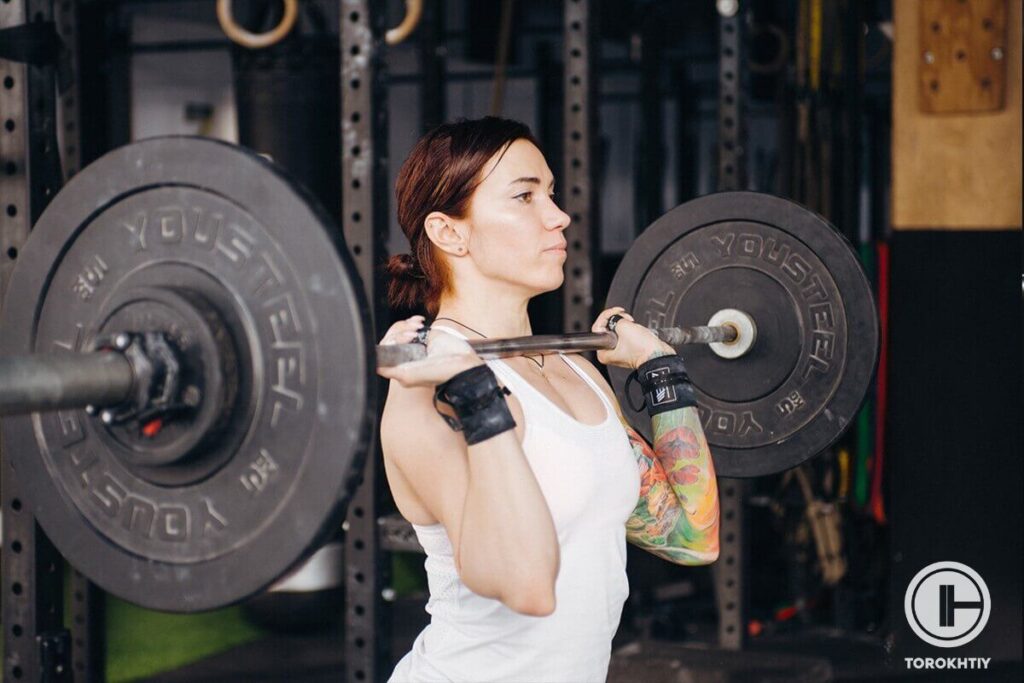
1. Beginner
Where everyone starts – as a beginner. If you’re a beginner, then you have little to no experience with weightlifting, particularly with barbells and free weights. You likely find it at least a tiny bit intimidating, but if you’re about to start, you’re also very excited about it. This is fantastic, but make sure to learn the basics first.
The most important thing is building a solid foundation. You need to learn proper technique and form because if you don’t master those first, there’s no chance you’ll have any benefits from weightlifting.
As far as the weights go, recommendations vary, but a good place to start is with 40-50% of your bodyweight. Make sure that the weights feel manageable because you want to be able to do 10-12 reps without compromising form.
Along with learning about form and technique, you can start with basic lifts like overhead squats, romanian deadlifts, and presses. Also, keep in mind that, at this stage, you should only use lighter weights because you want to prevent any potential injuries.
Full-body workouts and establishing balanced strength should be your focus. Don’t push yourself too hard and don’t stress over progress too much.
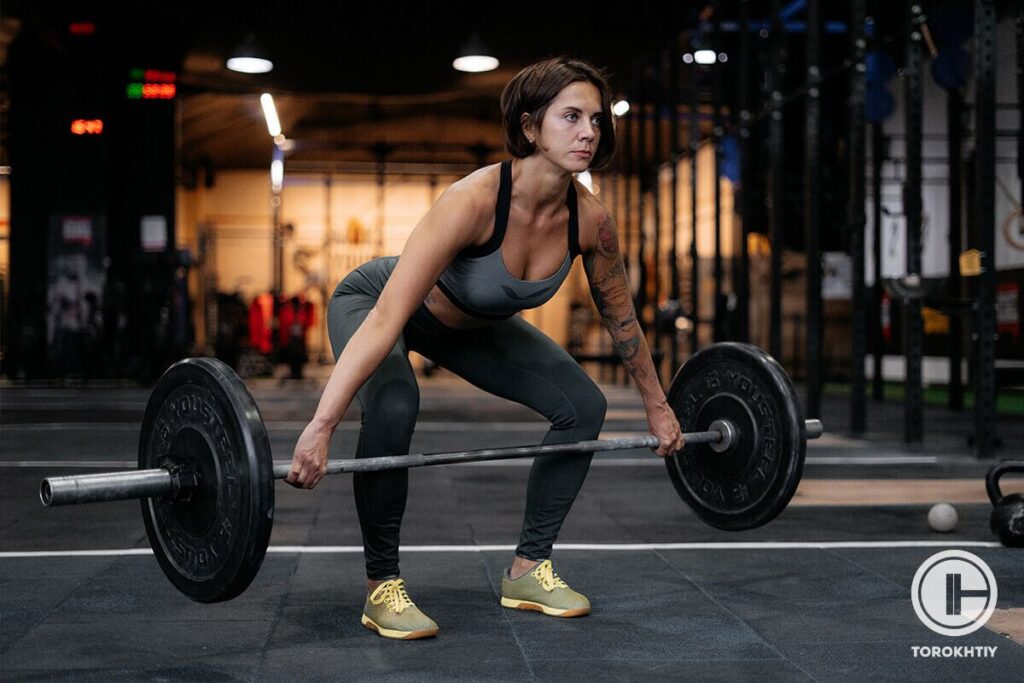
2. Intermediate
Lifters at the intermediate level have some experience with strength training and are comfortable with basic workouts. They have mastered the form and are able to keep it at all times.
If you’re at this level, then you have a solid foundation to progress upon and you can handle lifting moderately heavy weights – 60-75% of your 1RM. For example, if your 1RM of the snatch is 100 lbs, target weights of 60-75 lbs.
This can be a challenging level to be at because, while you’re seeing progress and are motivated by it, you can also have a lot of anxiety about progressing forward. Progress is key at this stage of your fitness level, but it shouldn’t be a source of stress.
What you want to do is to slowly increase the weights (by about 5-10%) while doing more complex exercises, like clean & jerks and snatches. A great way to safely move forward is to develop a workout plan.
You can do this on your phone or you can just write it down on a piece of paper. A well-designed workout plan includes a lot of different workouts that target different muscle groups.
Two other very important things are nutrition and recovery. You want to support muscle growth and health, so make sure your diet includes enough protein, and don’t skip those rest days!
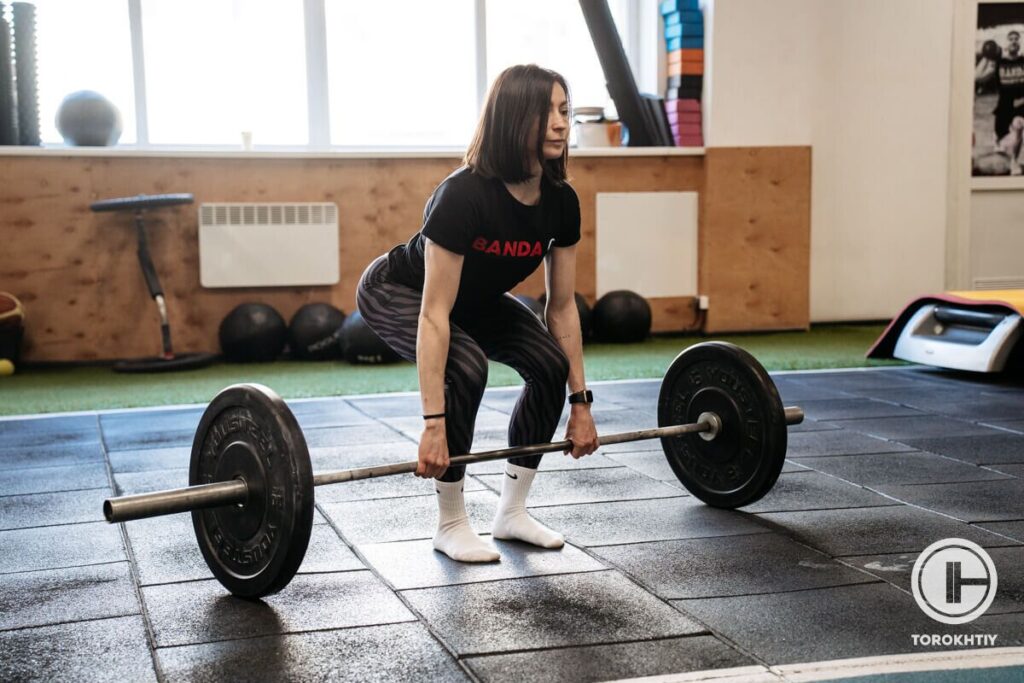
3. Advanced
The first thing to do – pat yourself on the back and congratulate yourself for staying motivated through all of the ups and downs a fitness journey brings about.
An advanced lifter has a lot of experience in weightlifting. They’re confident, know how to maintain correct form and they can lift heavy weights. A lot of advanced weightlifters also have specific goals set, like participating in Olympic weightlifting competitions.
Training becomes very specialized at this level. If you’re an advanced lifter, then your priority should be a set of well-defined goals and structured programs that will allow you to reach those goals. Challenge yourself with weights around 80-95% of your 1RM.
You want to include advanced exercises like snatches, C&J complexes, deficit deadlifts, drop snatches and paused lifts . You may also struggle with plateaus, which can be very challenging to overcome mentally.
Resistance training and advanced techniques can help break through plateaus, but you also need to keep your mind in check and don’t let yourself get frustrated.
Much like for the intermediate level, healthy nutrition is something you need to pay a lot of attention to. Targeted mobility training also plays a part in maintaining your performance, and so do rest days and scheduled recovery.
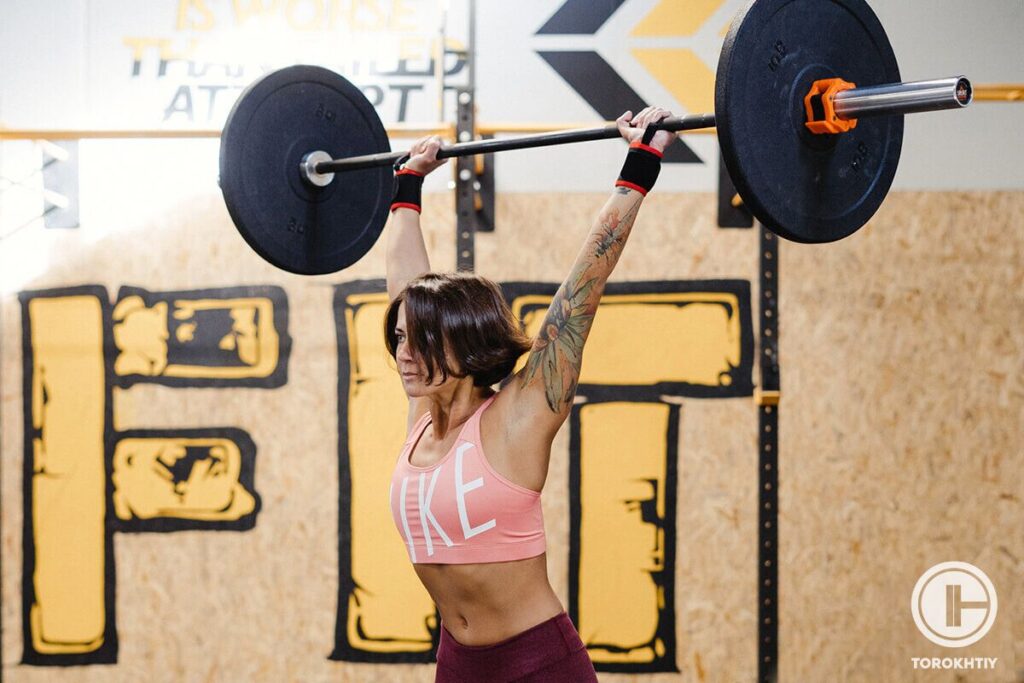
7 Key Factors in Women’s Weightlifting Routine
A good routine is the foundation of progress, and you won’t get very far by doing your workouts sporadically.
Free weights, notably the barbell, really shine when it comes to sculpting strong, lean bodies. An effective workout plan can help you get there even faster because organization plays a big part here.
You want to maximize your routine’s benefits and the way to do that is to familiarize yourself with key factors.
1. Setting Goals
Before you even start, ask yourself what it is you want to gain from this. Do you want to build muscle, get stronger, or improve your fitness level overall?
If you set a clear goal, then you know what direction to go in, and you’ll also stay motivated longer.
2. Frequency
Consistency is key to getting any results, so you probably already know that how often you work out impacts the results you get. Being consistent is not only going to help your progress, but it will also help you build good habits.
When it comes to your muscles, they need time to adapt to your new workout routine so they can grow over time. This is why it’s important to have regular lifting sessions and stick to your schedule.
The frequency at which you work out is also going to improve your technique and neuromuscular coordination. You are also a lot less likely to lose focus on your fitness goals if you stay consistent.
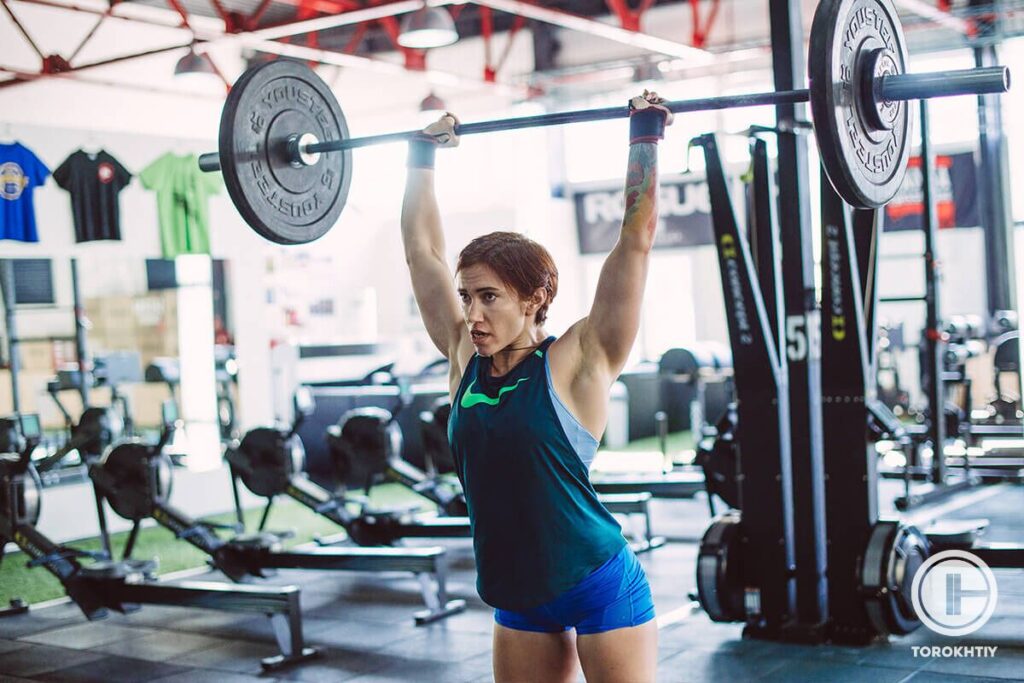
3. Intensity
This refers to the level of resistance or load applied during weightlifting. You may think that the harder you work, the more you’re going to progress. But that is not necessarily the case. It’s progressive overload you want, not crazy intensity right from the start.
You should up the intensity slowly, as you get used to the lifting, because this is what’s going to keep your muscles continually challenged.
With the intensity of your workouts increasing, you’ll notice your muscles getting stronger. It will also help with losing fat and giving your metabolism a kick to work even faster.
If you take your time and increase the intensity slowly, you are less likely to hit a plateau because your muscles will always be challenged and you will be able to see results on a continuous basis.
4. Volume
Volume is the total amount of weight you lift during a workout. You calculate it with the following formula: sets x reps x weight. Volume will help your muscles grow, but remember that you need to progress slowly.
5. Variety
Your workouts need to vary, and you can’t master one or two moves and then do them on repeat. That, unfortunately, won’t challenge your muscles enough for you to see results, and you’ll come to a plateau very soon and stay there.
If you’re having trouble with thinking of exercises to do, you can always ask for a professional trainer to help with that. Having a good variety of exercises will not only help you progress, but it will also prevent boredom. It keeps things interesting and motivating and makes you look forward to your workout.
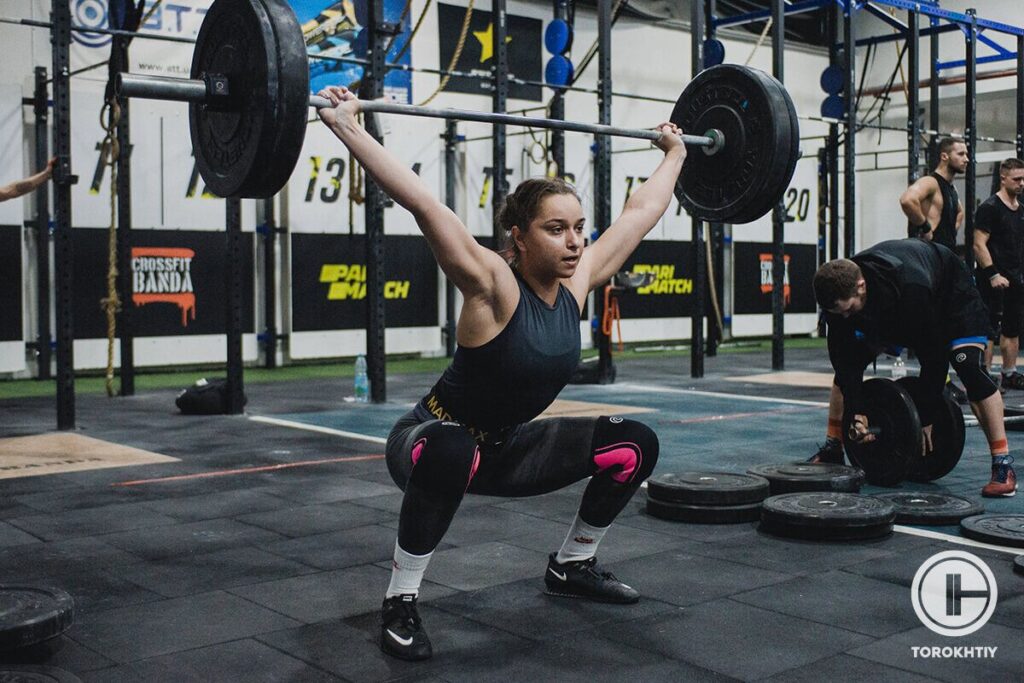
6. Nutrition and Hydration
These are just as much a part of your fitness journey as the actual workouts. Good nutrition is like fuel for your workouts, and staying hydrated is important for your health and performance.
A proper diet is well-balanced and rich in nutrients. It will provide you with enough energy for your weightlifting sessions. Protein will help your muscles recover faster and it will also help them grow.
Always make sure your diet contains enough proteins because if it does not, you won’t see any changes in the size of your muscles.
Water is equally important and will support metabolic processes. Drink water before, during, and after your workout to prevent dehydration.
7. Recovery and Deloading
Overtraining is a real thing and becomes an issue when women don’t take it seriously. Muscles work hard during weightlifting, so it makes sense that they need time to recover.
The women’s weightlifting plan needs to include recovery, such as rest days or deloading weeks. Rest days mean just what it says – you rest 100%. No strength training, no cardio, nothing but relaxing. Deloading weeks, on the other hand, include light training.
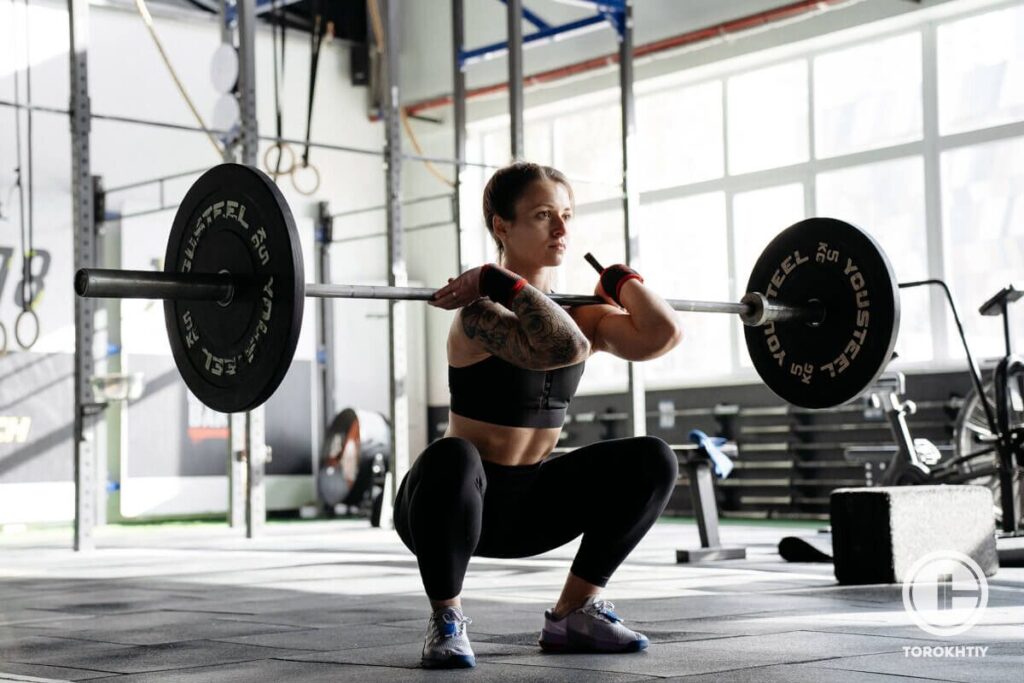
Women’s Olympic 12-Week Weightlifting Program
We’ve already gone over the importance of a well-designed Olympic weightlifting program for women. You can ask for a trainer to set it up for you, of course, but if you don’t want the added expense, you’ll be happy to check out this section.
This is a quick summary of a week-long program so that you get an idea of what each of the 12 weeks in the Women 2.0 Olympic weightlifting program will look like.
The Women 2.0 12-week-long Olympic weightlifting plan for women contains balanced workouts that target different muscle groups, so we want to provide you with the same.
This 5-day program revolves around free weights, specifically the barbell, because that is what helps women build strength and lean, toned muscles without getting bulky.
It will keep your body challenged, will allow you to progress slowly, and it will also give you enough time for your muscles to recover.
Let’s dive in!
Day 1
The first day starts with 12 reps of hyperextensions, and then 10 reps of PVC overhead duck walks.
Then, do the PVC muscle snatch from above the knee and then below the knee; you’ll use your 1RM of the snatch for reference. Based on the formula, this would be either 50%/(2+2)*6, 60%/(2+1)*2 or 65-70%/(2+1)*6, so choose the appropriate weight and rep combination for your level.
Formula Explained:
The “50%” refers to your Repetition Maximum (RM). So if your RM for snatch is 440 lbs, in the above scenario, you’d be working with a weight of 220 lbs. Next is the ‘(2+2)’ part, which refers to completing 2 reps of snatches from above the knee followed by 2 reps of snatches from below the knee. And the final “*6” tells you how many sets you are to complete. In this case, it’s six.
After, you’ll work on the snatch pull combined with the snatch pull from below the knee using your 1RM of the snatch. The formula you should follow is 70%7(1+3)*2 or 80%/(1+3)*5.
This gives you a range of work based on your comfort and proficiency. Once you’re done, move on to the back squat, where you’ll be referencing your 1RM of back squat.
The formula you should follow is 50%/5*2 or 60%/5*4.
Finish with the snatch sots press, doing 4 sets of 12 reps.
Day 2
The second day starts with 12 reps of the superman and then 15 reps of abs.
Your main lifting starts with clean pulls until the power position, followed by three muscle squat cleans; this combination is executed for 3 sets, with 3 reps per set.
Next, you’ll do cleans from blocks combined with front squats, using your 1RM of the clean & jerk for weight calculation. The formulas to follow are 50%/(3+3)*2, 60%/(3+2)*3 or 70%/(2+1)*3.
Next, move on to clean pulls from blocks, again referencing your !RM of the clean & jerk. Here, guide yourself by either 80%/4*3 or 90%/3*3.
To finish, do a superset – 2 sets of 12 reps of bicep curls and then 2 sets of 20 reps of the wrist flexion.

Day 3
Start the third day with 12 reps of hyperextensions and then transition to bodyweight squats, doing 5 reps on each leg.
You’ll then do the muscle snatch followed by overhead squat; this combo is based on your 1RM of the snatch. Do 3 sets with a 3+3 rep scheme.
Then, go on to front squats combined with jerks, using 1RM of the clean & jerk to determine the weight. You can follow any of the formulas – 50%/(2+3)*2, 60%/(2+2)*2, 65%/(2+2)*2 or 70%/(1+2)*3.
Next are push presses, again referencing your 1RM of C&J. For these, use the formula 50%/3*4.
Round off this day with press in split combined with overhead split squats. Do this for 3 sets, maintaining a rep scheme of 4+4+4+4 for each set.
Day 4
Kick off day 4 with 12 reps of hyperextensions and then do 6 reps of box jumps. Proceed to the clean warmup routine and do 8 reps.
The core of today’s session involves power cleans combined with power cleans below the knee. Reference your 1RM of C&J for the weights. Guide yourself by any of these formulas – 50%/(1+3)*2, 60%/(1+2)*2 or 70%/(1+1)*5.
Continue to the deficit clean pull, again referencing your 1RM of C&J. Here, you can choose between these two – 70%/4*3 or 85%/4*3.
To finish your session, do a superset; 4 sets of 8 reps of the military press, and then 3 sets of planks, with each lasting for 30 seconds.
Make sure to end each day with a cool-down.
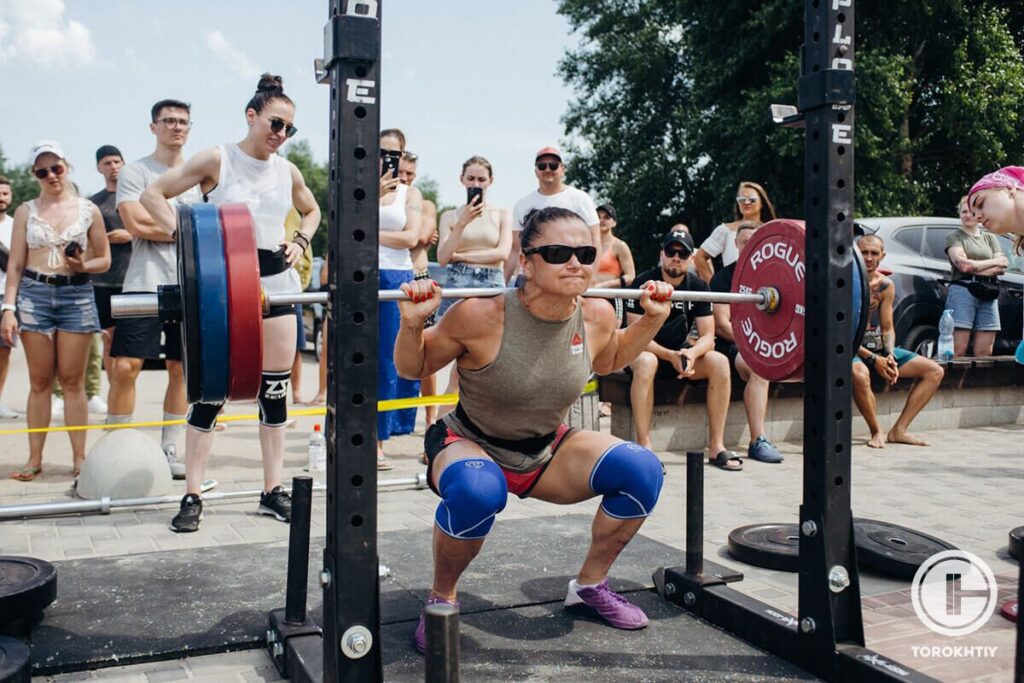
Day 5
The fifth day starts with 12 reps of the superman, followed by 15 reps of abs.
Next, do 3 sets of 6 reps of PVC snatches onto the plates and focus on your technique and speed.
Transition to the power snatch combined with an overhead squat. Use your 1RM of the snatch (SN) to determine your weights. You can go by these formulas to guide your workout – 50%/(2+2)*2, 60%/(2+1)*2, 65%/(2+1)*2 or 70%/(1+1)*4. The formula you shoes should align with your current training focus.
Move on to the medium grip pull and base your weights on your 1RM of SN. You can choose between 70%/4*2 or 80%/4*4.
Then follow this by back squats, referencing your 1RM of BS for the weights. Go by either 50%/4*2 or 60%/4*4, based on your comfort and goals.
To finish, do a superset that targets your glutes and calves – 2 sets of 20 reps of glute bridges and then 2 sets of 20 reps of calf raises.
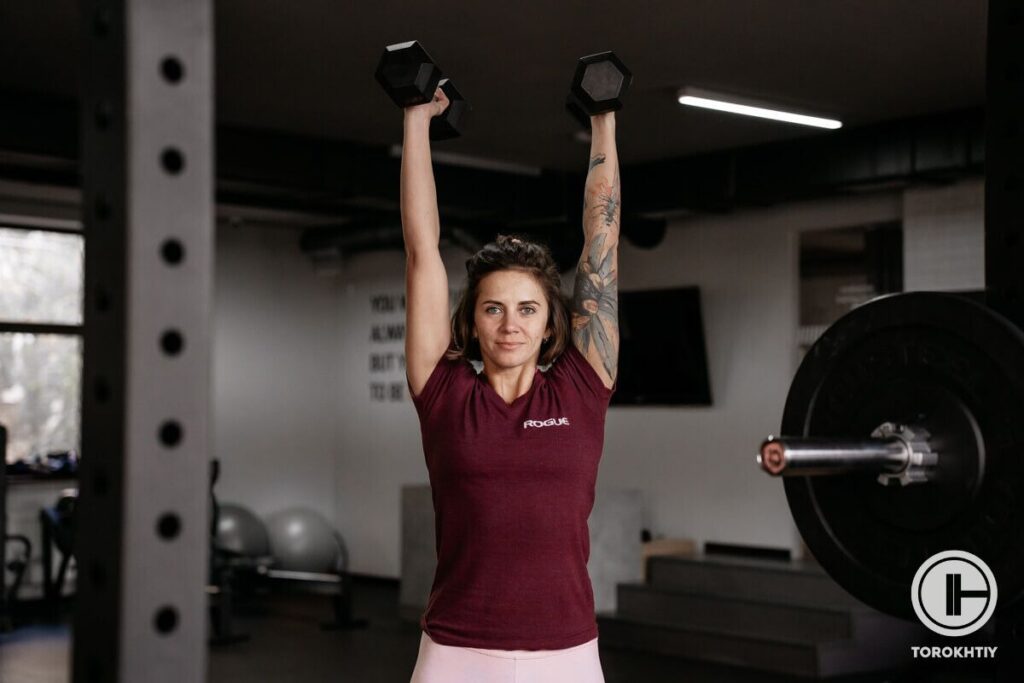
5 Common Women’s Olympic Weightlifting Program Mistakes
The most important thing about mistakes you need to know is that you’re going to make them. There is no way around it, even if you’re not a beginner. Mistakes, however, are not bad. Also, they’re an opportunity to grow and get better, so look at them that way.
With that being said, there are some mistakes most women make when training for Olympic weightlifting and there are, of course, ways of preventing them.
Women are (mostly) after a feminine physique and will make mistakes out of fear of getting bulky. Let’s take a look at some that are the most common.
1. Overemphasis on Technique
You can’t argue about the importance of technique when it comes to Olympic weightlifting. However, focusing on technique only and not having enough strength training can slow your progress.
What you need is balance – both strength training and correct technique are important for optimal performance, especially when it comes to snatches and clean & jerks.
2. Not Enough Strength Training
Most of the women who lift want lean, defined bodies without bulk. Because of that, a lot of them will neglect women’s strength training program; they’re simply too afraid of getting bulky.
A lot of them focus on cardio or low weight and think that’s the best way to progress, while keeping their body lean.
There’s no arguing that these have their benefits, but a strength training program for women is an absolute must for building lean muscle and getting toned, so you should not avoid it.
If you take a look at the training program above, you’ll see it’s all about the barbell and free weights. This is because those promote building lean muscles, not bulk.
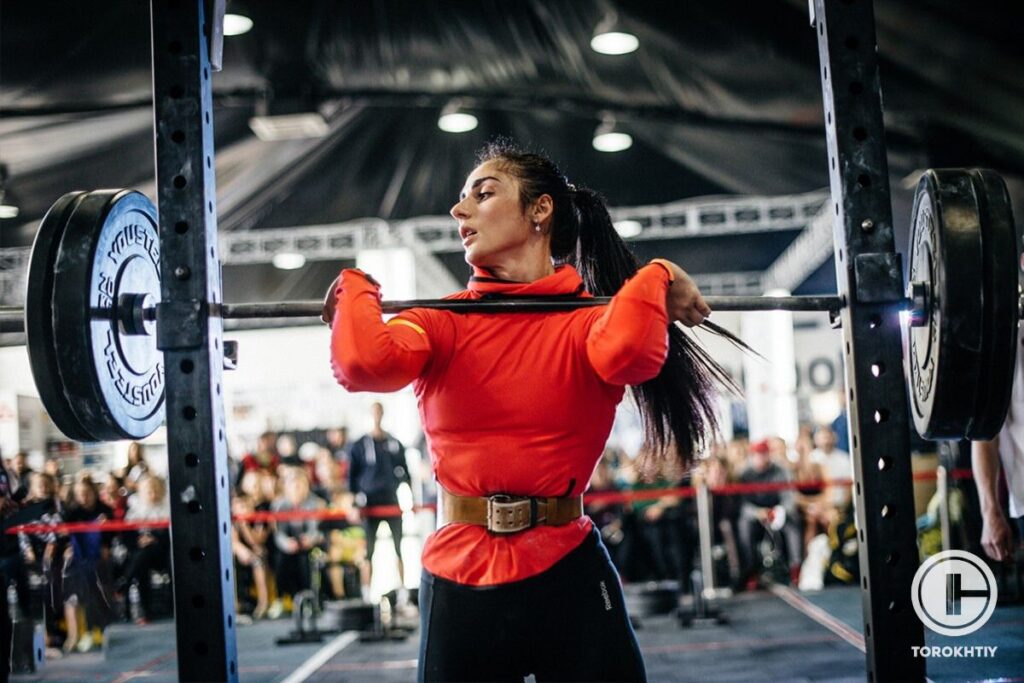
3. Lifting Only Light Weights
Another mistake that comes from the fear of getting masculine and bulky. But if you want to lose fat and get your muscles to be lean and feminine, you simply need to lift heavier weights. Don’t be afraid to challenge yourself and slowly add more weight.
4. Doing Repetitive Workouts
Do you know what plateaus are? If you do, then you most likely also know they come from repetitive exercises. If you do the same thing over and over again, your muscles get used to the workout, they’re not challenged, and you eventually stop seeing results.
Make sure to include a lot of different workouts into your fitness routine to keep seeing results.
5. Neglecting Compound Movements
Olympic weightlifting thrives on compound movements. Using machines to isolate certain muscles has its benefits, but it’s far from ideal. Squats, snatches, cleans and pulls are much more effective because they engage multiple muscle groups simultaneously, which means that your overall results are better.
Women’s weightlifting workout plan that does not include compound movements will not be nearly as effective as the one that does.
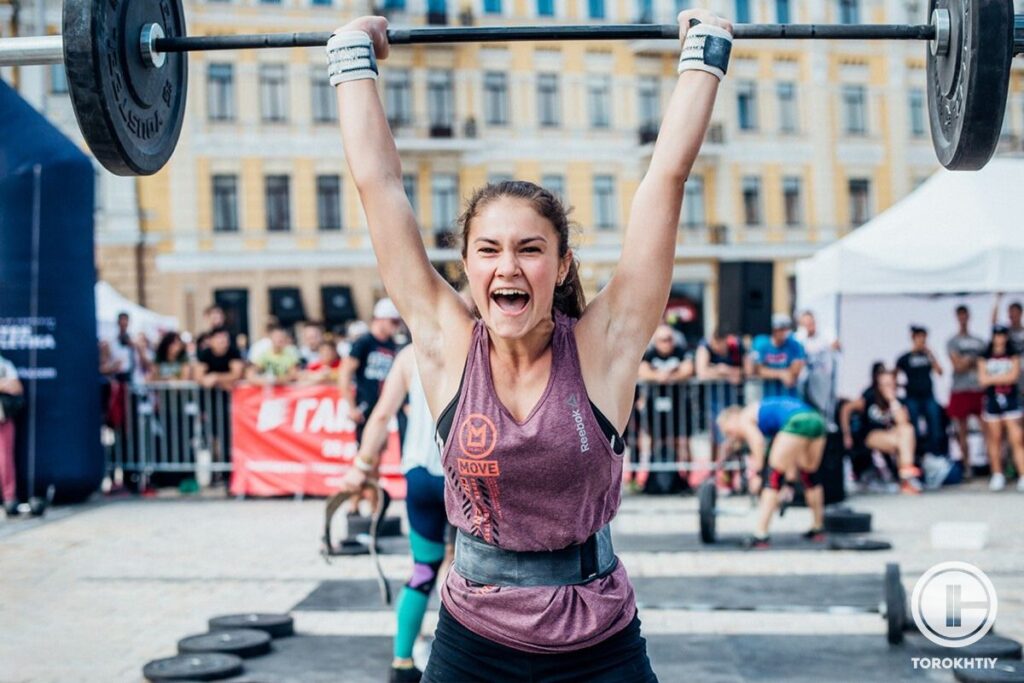
6. Fear of Bulking Up
This is something that will hold a lot of women back and will keep their results mediocre at best. The thing with bulking up is that you need testosterone for it.
If the hormone testosterone is what makes men men, then estrogen is the hormone that makes women women. As a result, women have significantly less testosterone than men do, and it’s very hard for women to get significant muscle mass.
Weightlifting won’t make you bulky; it will make your body lean, toned, and feminine. With that being said, everyone is built differently, and everybody is a unique machine. And getting significant muscle mass for women is possible.
Take before and after pictures (every week) for comparison, and consult a trainer to check how you’re doing muscle mass-wise.
FAQ
Do I Need a New Female 2.0 Program if I Trained According to the Female 1.0 Program?
The answer is yes, 100%! Weight training program for women is a completely new program. This training program is unique, fun, and add a different stimulus each week. We are implementing hypertrophy, power, and absolute strength to keep you healthy while building strength, athleticism and improving your lifts.
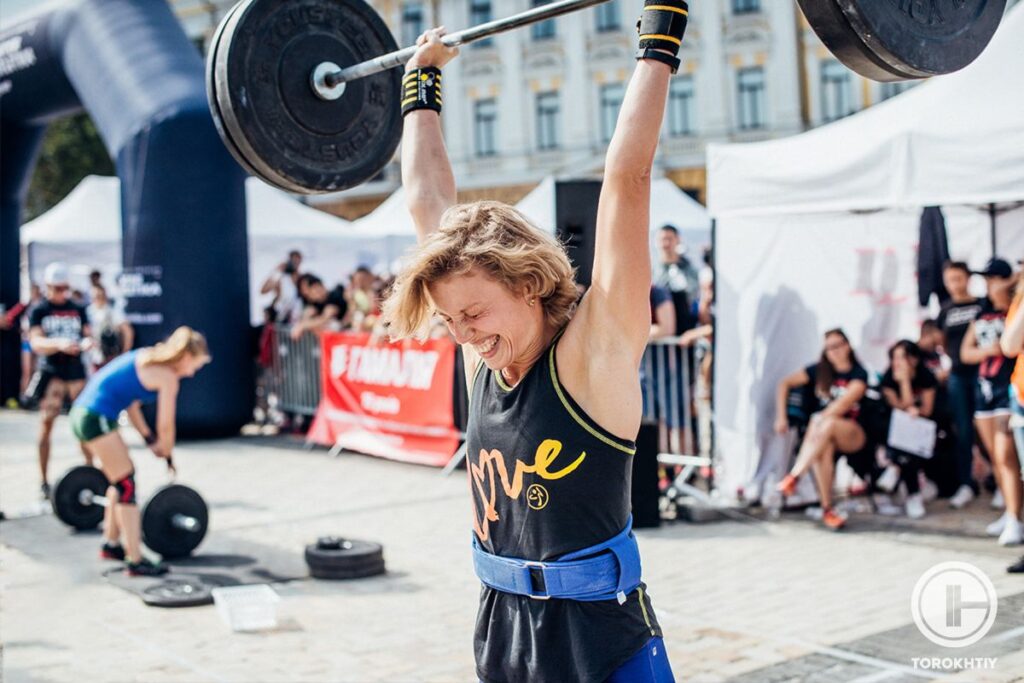
How Frequently Should I Train?
This strength training program for women is designed to be 5 days per week. We do not recommend training 4 days in a row. On your rest days, try to plan recovery activities, such as massages, or sauna.
Can I Combine It With Other Types of Training?
We do not recommend combining this womens weight lifting plan with other high-intensity workouts. You can add, at your discretion, recovery activities to develop flexibility and mobility, as well as short (up to 30 minutes) low-intensity cardio work (walking, rowing, swimming).
Be sure to plan one full day off in each weekly cycle. The weight lifting routine for women effectiveness largely depends on your responsibility when it comes to the training process, sleep, nutrition, and recovery. Train smart, get enough rest.
Is It Necessary to Train in Weightlifting Shoes?
We highly recommend you wear weightlifting shoes, also known as Lifters. Whether you’re a functional fitness athlete or a weightlifter, you will find them beneficial.
What Equipment Do I Need for the Weight Training Routine for Woman?
- Barbell and Bumper Plates
- Squat Rack
- PVC
- GHD
- Shoulders activation system
- Lifting straps
- Rubber bands
- Blocks
- Kettlebells
- Plyometric Box
What if I Have More Questions?
Please contact us at [email protected]
Also Read:
- 2 Day a Week Olympic Weightlifting Program
- 6 Day Olympic Weightlifting Program
- 12-Week Squat Program
- Olympic Weightlifting Program
- Olympic Weightlifting Program for Beginners
References:
1. Sherry Landow, “Strength training can burn fat too, myth-busting study finds”; Science Daily, https://www.sciencedaily.com/releases/2021/09/210922121905.htm (accessed 4 September, 2023).
2. n/a, “Slowing bone loss with weight-bearing exercise”; Harvard Health Publishing, https://www.health.harvard.edu/staying-healthy/slowing-bone-loss-with-weight-bearing-exercise (accessed 4 September, 2023).
3. Khaled A. Alswat, “Gender Disparities in Osteoporosis”; National Library of Medicine, https://www.ncbi.nlm.nih.gov/pmc/articles/PMC5380170/ (accessed 4 September, 2023).
4. Sangeeta Sangwan, M.Physio, Rodney A. Green PhD, Nicholas F. Taylor PhD, “Characteristics of Stabilizer Muscles: A Systematic Review”; National Library of Medicine https://www.ncbi.nlm.nih.gov/pmc/articles/PMC4403366/ (accessed 4 September, 2023).
5. Venkat S.R., “What Are Muscle Imbalances?”; WebMD, https://www.webmd.com/fitness-exercise/what-are-muscle-imbalances (accessed 4 September, 2023).
6. Emma Childs, Harriet de Wit, “Regular exercise is associated with emotional resilience to acute stress in healthy adults”; National Library of Medicine, https://www.ncbi.nlm.nih.gov/pmc/articles/PMC4013452/ (accessed 4 September, 2023).
7. Jennifer Berry, Alicia Sparks Akers, “What to know about endorphins”; Medical News Today, https://www.medicalnewstoday.com/articles/320839 (accessed 4 September, 2023).
8. R Pratley, B Nicklas, M Rubin, J Miller, A Smith, M Smith, B Hurley, A Goldberg, “Strength training increases resting metabolic rate and norepinephrine levels in healthy 50- to 65-yr-old men”; National Library of Medicine, https://pubmed.ncbi.nlm.nih.gov/8175496/ (accessed 4 September, 2023).
9. Maria Grazia Benedetti, Giulia Furlini, Alessandro Zati, Giulia Letizia Mauro, “The Effectiveness of Physical Exercise on Bone Density in Osteoporotic Patients”; National Library of Medicine, https://www.ncbi.nlm.nih.gov/pmc/articles/PMC6323511/ (accessed 4 September, 2023).
10. Frank Mayer Prof. Dr. med., Friederike Scharhag-Rosenberger Dr. phil., Anja Carlsohn Dr. rer. nat., Michael Cassel Dr. med., Steffen Müller Dr. phil., Jürgen Scharhag PD Dr. med., “The Intensity and Effects of Strength Training in the Elderly”; National Library of Medicine, https://www.ncbi.nlm.nih.gov/pmc/articles/PMC3117172/ (accessed 4 September, 2023).
11. Katherine J. Hamilton, Sylvia C. Hewitt, Yukitomo Arao, Kenneth S. Korach, “Estrogen Hormone Biology”; National Library of Medicine, https://www.ncbi.nlm.nih.gov/pmc/articles/PMC6206851/ (accessed 4 September, 2023).12) Richard V Clark, Jeffrey A Wald, Ronald S Swerdloff, Christina Wang, Frederick C W Wu, Larry D Bowers, Alvin M Matsumoto, “Large divergence in testosterone concentrations between men and women: Frame of reference for elite athletes in sex-specific competition in sports, a narrative review”; National Library of Medicine, https://pubmed.ncbi.nlm.nih.gov/30136295/ (accessed 4 September, 2023).
Why Trust Us?
With over 20 years in Olympic Weightlifting, our team does its best to provide the audience with ultimate support and meet the needs and requirements of advanced athletes and professional lifters, as well as people who strive to open new opportunities and develop their physical capabilities with us.
By trusting the recommendations of our certified experts in coaching, nutrition, dietology, and sports training programming, as well as scientific consultants, and physiotherapists, we provide you with thorough, well-considered, and scientifically proven content. All the information given in the articles concerning workout programming, separate exercises, and athletic performance, in general, is based on verified data. We ensure that you can rely on our professionals’ pieces of advice and recommendations that can be treated as personalized ones which will benefit you and fully meet your needs.
The product testing process is described in more detail here
Author: Sergii Putsov
Head of Sport Science, PhD
Best Results: Snatch – 165 kg,
C&J – 200 kg
Sergii Putsov, Ph.D., is a former professional weightlifter and National team member, achieving multiple medals in the 94 kg weight category at national competitions. With a Master’s degree in “Olympic & Professional Sport Training” and a Sport Science Ph.D. from the International Olympic Academy, Greece, Sergii now leads as the Head of Sport Science. He specializes in designing training programs, writing insightful blog articles, providing live commentary at international weightlifting events, and conducting educational seminars worldwide alongside Olympic weightlifting expert Oleksiy Torokhtiy.
Reviewed by: Oleksiy Torokhtiy
Olympic Weightlifting Champion
Best Results: Snatch – 200 kg,
C&J – 240 kg
Oleksiy Torokhtiy is a professional athlete boasting 20 years of experience in Olympic weightlifting. With multiple European and World titles under his belt, he has showcased his prowess in two Olympic Games (Beijing 2008 and London 2012). Upon concluding his illustrious career, Oleksiy dedicated himself to coaching. By 2022, he had conducted over 200 weightlifting seminars worldwide. He is the visionary behind an international sportswear and accessories brand known for its motto, “Warm Body Cold Mind.” Additionally, he is an esteemed author and the creator of a series of training programs and eBooks.

